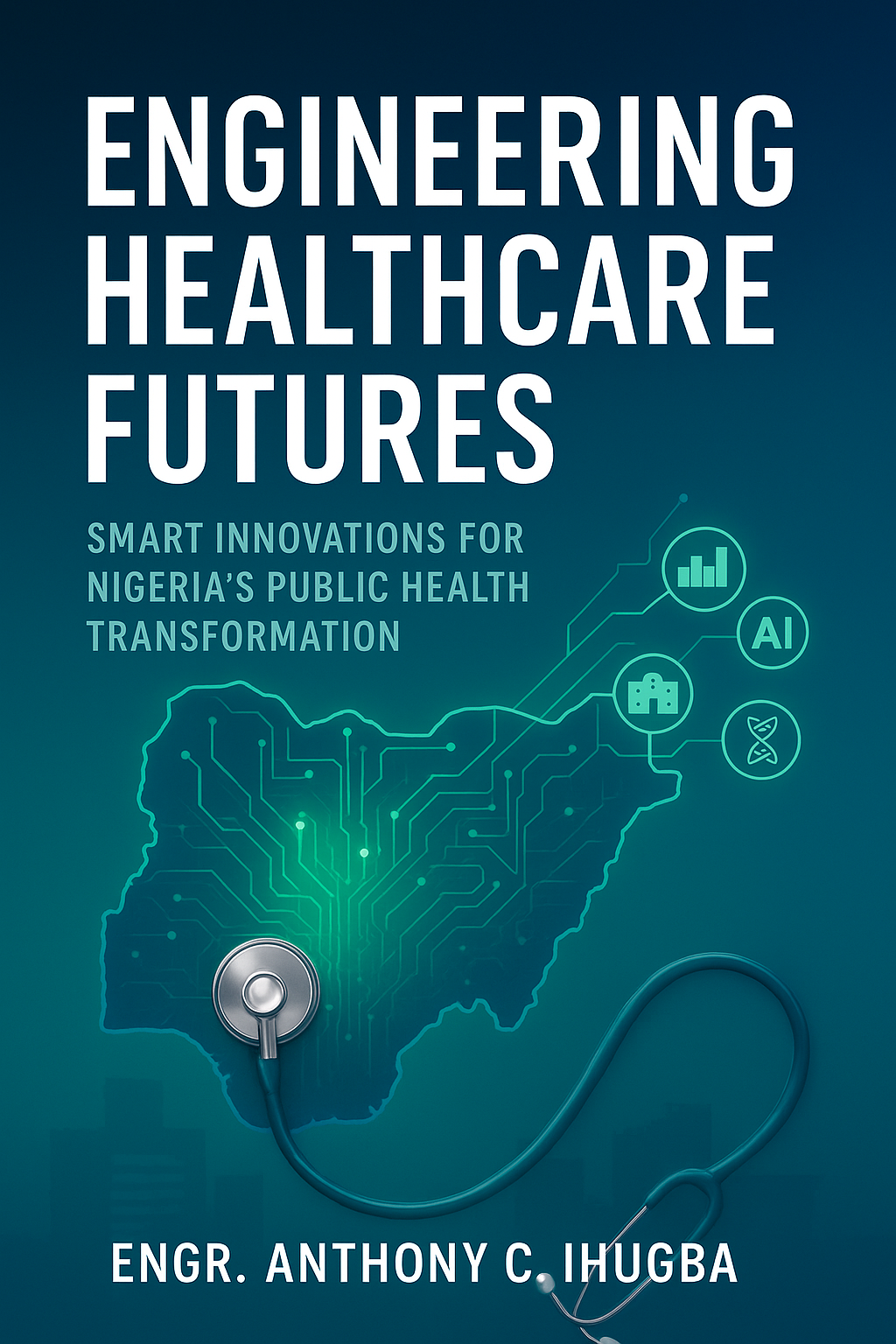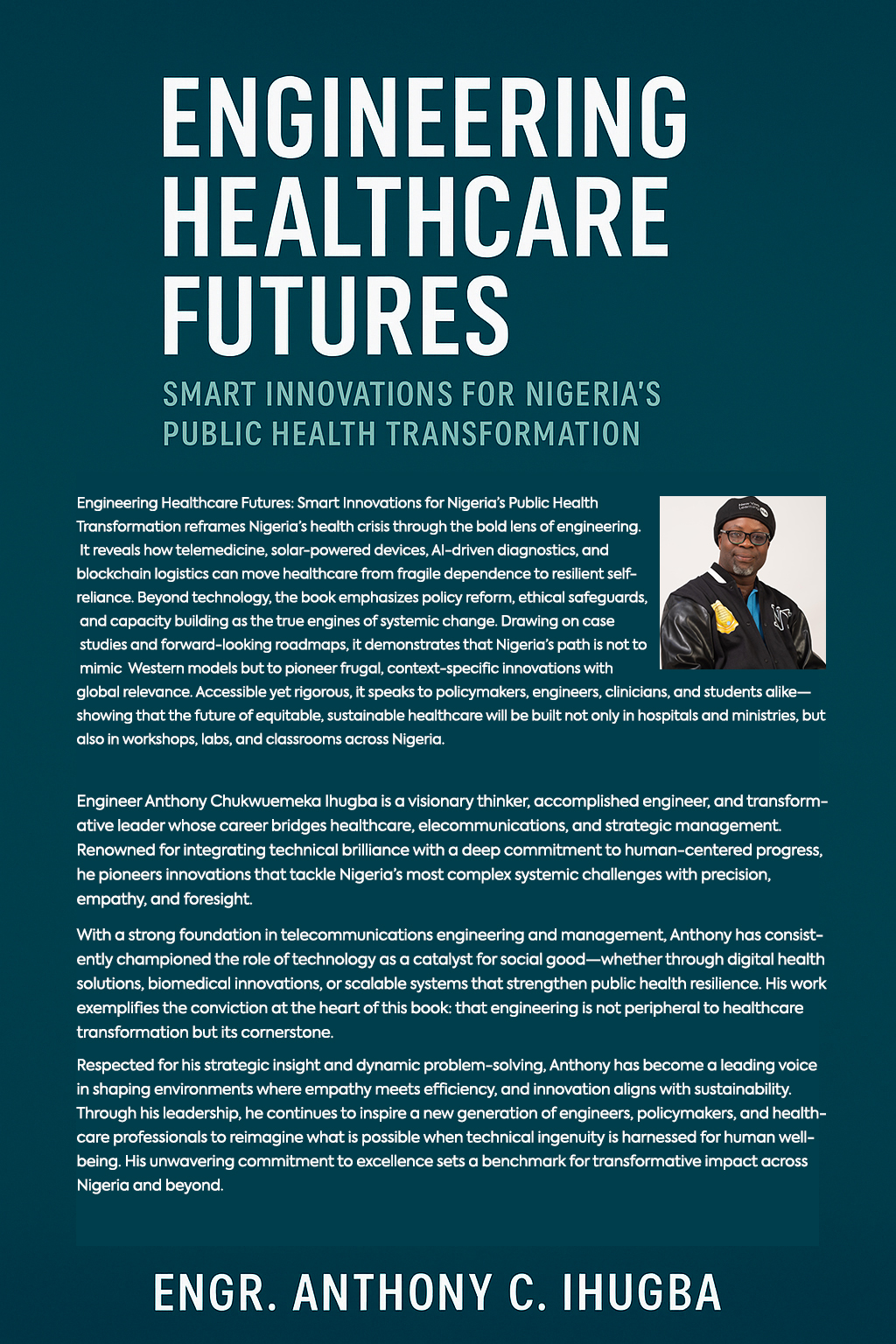Book Overview
Nigeria’s healthcare system stands at a crossroads—caught between persistent structural challenges and the promise of transformative innovation. Engineering Healthcare Futures: Smart Innovations for Nigeria’s Public Health Transformation positions engineering as a powerful, yet often underexplored, driver of health system reform. It argues that Nigeria’s path toward sustainable, equitable, and resilient healthcare lies not only in clinical interventions but also in the systematic application of engineering solutions that are context-specific, scalable, and future-oriented.
The book is structured across twelve chapters, each exploring a key dimension of how engineering principles intersect with healthcare delivery. It begins with a detailed introduction to Nigeria’s current health crisis, outlining the burdens of disease, infrastructure deficits, and chronic underfunding that limit access and outcomes. This sets the stage for understanding why innovative approaches are urgently needed. The early chapters also provide a historical and theoretical grounding, tracing the evolution of healthcare and technology in Nigeria and introducing systems thinking as a framework for integrating engineering into public health.
The heart of the book lies in its exploration of engineering-led solutions to Nigeria’s most pressing healthcare challenges. Chapters 4 through 8 examine how innovations in digital health, smart devices, hospital infrastructure, biomedical engineering, artificial intelligence, supply chain management, and logistics can bridge long-standing gaps in service delivery. Telemedicine platforms, mobile health apps, wearable technologies, solar-powered hospital equipment, and blockchain-based supply chain systems are presented as practical case studies of how technical ingenuity can directly improve care. Each solution is carefully analyzed in terms of opportunities, barriers, and contextual realities, offering readers both inspiration and grounded critique.
Another major theme is the role of human capital and capacity building. Chapters 9 and 10 emphasize that technology alone cannot transform healthcare without a skilled workforce, supportive policies, and ethical safeguards. Engineering-focused medical education, cross-disciplinary training, mentorship programs, and workforce resilience strategies are shown to be essential for sustaining innovation. At the same time, attention is given to the regulatory and ethical dimensions of healthcare transformation—particularly around digital health governance, AI ethics, data privacy, and the regulation of traditional and complementary medicine. These chapters underscore the importance of balancing innovation with responsibility, trust, and inclusivity.
Case studies form a core strength of the book. Chapter 11 draws on recent Nigerian experiences with digital health startups, blockchain frameworks, mobile-based insurance systems, and sustainability-focused hospital designs. These examples demonstrate how localized, context-aware engineering innovations are already reshaping healthcare delivery. They also highlight the importance of supportive ecosystems—policies, partnerships, and funding mechanisms—that allow small-scale pilots to scale into nationwide solutions.
The final chapter synthesizes the book’s findings into a forward-looking roadmap. It emphasizes engineering as a cornerstone of resilient healthcare futures, not a peripheral supplement. AI-driven vaccination optimization, modular hospitals, and frugal biomedical devices are presented as models of how Nigeria can leapfrog into a smarter healthcare era. Yet the conclusion also stresses that sustainable progress will depend on governance reforms, capacity building, policy alignment, and ethical accountability.
Overall, this book makes three key contributions. First, it reframes healthcare transformation in Nigeria through the lens of engineering, expanding the conversation beyond traditional public health interventions. Second, it demonstrates that innovation must be both technological and systemic—linking devices and platforms to policy, training, and governance structures. Third, it positions Nigeria as a potential leader in frugal, scalable health innovations that not only serve its own population but also provide models for other low- and middle-income countries.
Accessible yet evidence-based, the book draws on scholarly research, policy analysis, and real-world case studies. It is designed for a diverse audience: policymakers seeking actionable strategies, health professionals interested in cross-disciplinary collaboration, engineers eager to apply their expertise to social challenges, and students studying health systems or biomedical engineering. By weaving together theory, practice, and vision, Engineering Healthcare Futures offers a comprehensive and hopeful perspective on what is possible when engineering is placed at the center of Nigeria’s public health transformation.







Reviews
There are no reviews yet.